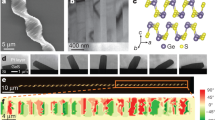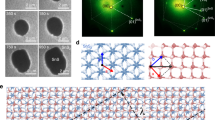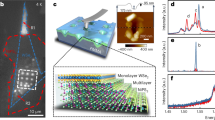Abstract
Van der Waals heterostructures with small misalignment between adjacent layers (‘interlayer twist’) are of interest because of electronic structure and correlation phenomena (such as superconductivity) that are determined by both the atomic lattice and long-range superlattice potentials arising in interlayer moiré patterns1,2,3,4,5,6,7. Previously, such twisted heterostructures have involved a single planar interface between layers isolated by exfoliation and micromechanically stacked in the desired relative orientation1,8,9,10,11,12. Here we demonstrate a class of materials—van der Waals nanowires of layered crystals—in which a tunable interlayer twist evolves naturally during synthesis. In vapour–liquid–solid growth, nanowires of germanium(ii) sulfide, an anisotropic layered semiconductor, crystallize with layering along the wire axis13 and have a strong propensity for forming axial screw dislocations. Nanometre-resolved electron diffraction shows that Eshelby twist, induced by a torque on the ends of a cylindrical solid due to the stress field of an axial dislocation14,15, causes a chiral structure in the van der Waals nanowires. The in-plane germanium sulfide crystal axes progressively rotate along the wire, and germanium sulfide layers in adjacent turns of the helix naturally form a moiré pattern because of their interlayer twist. The axial rotation and the twist are tunable by varying the nanowire thickness. Combined electron diffraction and cathodoluminescence spectroscopy show the correlation between the interlayer twist and locally excited light emission that is due to progressive changes in the lattice orientation and in the interlayer moiré registry along the nanowires. The findings demonstrate a step towards scalable fabrication of van der Waals structures with defined twist angles, in which interlayer moiré patterns are realized along a helical path on a nanowire instead of a planar interface.
This is a preview of subscription content, access via your institution
Access options
Access Nature and 54 other Nature Portfolio journals
Get Nature+, our best-value online-access subscription
$29.99 / 30 days
cancel any time
Subscribe to this journal
Receive 51 print issues and online access
$199.00 per year
only $3.90 per issue
Buy this article
- Purchase on Springer Link
- Instant access to full article PDF
Prices may be subject to local taxes which are calculated during checkout



Similar content being viewed by others
References
Dean, C. R. et al. Hofstadter’s butterfly and the fractal quantum Hall effect in moiré superlattices. Nature 497, 598–602 (2013).
Liu, K. et al. Evolution of interlayer coupling in twisted molybdenum disulfide bilayers. Nat. Commun. 5, 4966 (2014).
Yeh, P.-C. et al. Direct measurement of the tunable electronic structure of bilayer MoS2 by interlayer twist. Nano Lett. 16, 953–959 (2016).
Carr, S. et al. Twistronics: manipulating the electronic properties of two-dimensional layered structures through their twist angle. Phys. Rev. B 95, 075420 (2017).
Cao, Y. et al. Unconventional superconductivity in magic-angle graphene superlattices. Nature 556, 43–50 (2018).
Cao, Y. et al. Correlated insulator behaviour at half-filling in magic-angle graphene superlattices. Nature 556, 80–84 (2018).
Ribeiro-Palau, R. et al. Twistable electronics with dynamically rotatable heterostructures. Science 361, 690–693 (2018).
Yankowitz, M. et al. Emergence of superlattice Dirac points in graphene on hexagonal boron nitride. Nat. Phys. 8, 382–386 (2012).
Ponomarenko, L. A. et al. Cloning of Dirac fermions in graphene superlattices. Nature 497, 594–597 (2013).
Kim, K. et al. van der Waals heterostructures with high accuracy rotational alignment. Nano Lett. 16, 1989–1995 (2016).
Kang, K. et al. Layer-by-layer assembly of two-dimensional materials into wafer-scale heterostructures. Nature 550, 229–233 (2017).
Frisenda, R. et al. Recent progress in the assembly of nanodevices and van der Waals heterostructures by deterministic placement of 2D materials. Chem. Soc. Rev. 47, 53–68 (2018).
Sutter, E. & Sutter, P. 1D wires of 2D layered materials: germanium sulfide nanowires as efficient light emitters. ACS Appl. Nano Mater. 1, 1042–1049 (2018).
Eshelby, J. D. Screw dislocations in thin rods. J. Appl. Phys. 24, 176–179 (1953).
Bierman, M. J., Lau, Y. K. A., Kvit, A. V., Schmitt, A. L. & Jin, S. Dislocation-driven nanowire growth and Eshelby twist. Science 320, 1060–1063 (2008).
Wagner, R. S. & Ellis, W. C. Vapor–liquid–solid mechanism of single crystal growth. Appl. Phys. Lett. 4, 89–90 (1964).
Morales, A. M. & Lieber, C. M. A laser ablation method for the synthesis of crystalline semiconductor nanowires. Science 279, 208–211 (1998).
Suryawanshi, S. R., Warule, S. S., Patil, S. S., Patil, K. R. & More, M. A. Vapor–liquid–solid growth of one-dimensional tin sulfide (SnS) nanostructures with promising field emission behavior. ACS Appl. Mater. Interfaces 6, 2018–2025 (2014).
Liu, S. et al. Solution-phase synthesis and characterization of single-crystalline SnSe nanowires. Angew. Chem. Int. Ed. 50, 12050–12053 (2011).
Peng, H., Meister, S., Chan, C. K., Zhang, X. F. & Cui, Y. Morphology control of layer-structured gallium selenide nanowires. Nano Lett. 7, 199–203 (2007).
Zhai, T. et al. Fabrication of high-quality In2Se3 nanowire arrays toward high-performance visible-light photodetectors. ACS Nano 4, 1596–1602 (2010).
Yang, R. B. et al. Pulsed vapor–liquid–solid growth of antimony selenide and antimony sulfide nanowires. Adv. Mater. 21, 3170–3174 (2009).
Alegria, L. D., Yao, N. & Petta, J. R. MOCVD synthesis of compositionally tuned topological insulator nanowires. Phys. Status Solidi 8, 991–996 (2014).
Burton, W. K., Cabrera, N. & Frank, F. C. The growth of crystals and the equilibrium structure of their surfaces. Phil. Trans. R. Soc. Lond. A 243, 299–358 (1951).
Bletskan, D. Production of GeS single crystals, investigation of their morphology and of latter influence on hologram recording. Kristallografiya 20, 1008–1012 (1975).
Sutter, P. & Sutter, E. Growth mechanisms of anisotropic layered group IV chalcogenides on van der Waals substrates for energy conversion applications. ACS Appl. Nano Mater. 1, 3026–3034 (2018).
Jain, A. et al. Commentary. The Materials Project: a materials genome approach to accelerating materials innovation. APL Mater. 1, 011002 (2013).
Bissert, G. & Hesse, K. F. Verfeinerung der struktur von germanium(II)-sulfid, GeS. Acta Crystallogr. B 34, 1322–1323 (1978).
Sutter, P., Argyropoulos, C. & Sutter, E. Germanium sulfide nano-optics probed by STEM-cathodoluminescence spectroscopy. Nano Lett. 18, 4576–4583 (2018).
Kociak, M. & Zagonel, L. F. Cathodoluminescence in the scanning transmission electron microscope. Ultramicroscopy 176, 112–131 (2017).
Hentschel, M., Schäferling, M., Duan, X., Giessen, H. & Liu, N. Chiral plasmonics. Sci. Adv. 3, e1602735 (2017).
Sutter, E. A. & Sutter, P. W. Size-dependent phase diagram of nanoscale alloy drops used in vapor−liquid−solid growth of semiconductor nanowires. ACS Nano 4, 4943–4947 (2010).
Wei, P.-C. et al. Room-temperature negative photoconductivity in degenerate InN thin films with a supergap excitation. Phys. Rev. B 81, 045306 (2010).
Tan, D. et al. Anisotropic optical and electronic properties of two-dimensional layered germanium sulfide. Nano Res. 10, 546–555 (2017).
Acknowledgements
The synthesis of twisted GeS nanowires, analysis of nanobeam diffraction and transport measurements were supported by the National Science Foundation, Division of Materials Research, Solid State and Materials Chemistry Program under grant no. DMR-1607795. The development of nanobeam electron diffraction correlated with locally excited CL spectroscopy measurements and of associated data analysis methods was supported by the US Department of Energy, Office of Science, Basic Energy Sciences, under award no. DE-SC0016343.
Reviewer information
Nature thanks Hua Zhang and the other anonymous reviewer(s) for their contribution to the peer review of this work.
Author information
Authors and Affiliations
Contributions
P.S. and E.S. planned the study, carried out the nanowire growth and the measurements, and analysed the data. S.W. analysed the electron diffraction data and performed device fabrication and transport measurements. P.S. and E.S. wrote the paper. All authors commented on the manuscript.
Corresponding authors
Ethics declarations
Competing interests
The authors declare no competing interests.
Additional information
Publisher’s note: Springer Nature remains neutral with regard to jurisdictional claims in published maps and institutional affiliations.
Extended data figures and tables
Extended Data Fig. 1 Electron microscopy of twisted GeS nanowires with axial screw dislocations.
a, High-resolution TEM image of a 65-nm GeS nanowire. The lattice fringes along the wire axis are spaced by 1.06 nm (that is, the GeS c-axis unit cell dimension). b, High-resolution STEM image of a 54-nm GeS nanowire. As in a, the lattice fringes along the wire axis are spaced by the GeS c-axis unit cell dimension.
Extended Data Fig. 2 GeS twist moiré patterns.
a, Illustration of a GeS twist moiré (here with 1° twist angle). Note the reversal of the ratio λa/λb = b/a, where (a, b) denote the in-plane lattice parameters of GeS, and λa, λb are the moiré periods along the a and b directions. b, Moiré periodicity for a twisted GeS van der Waals interface as a function of interlayer twist angle. Data points were obtained from overlays of models of two GeS monolayers with different relative orientation. The solid line is a power-law fit λ ∝ ϕ−1 to the data.
Extended Data Fig. 3 STEM-CL line scan along a twisted GeS nanowire measured at T = 110 K.
a, HAADF-STEM image of a GeS nanowire (diameter about 44 nm). b, Position-dependent STEM-CL spectra recorded along the nanowire at points marked in a (T = 110 K). Lines are Gaussian fits to the dominant band-edge luminescence peak. c, Plots of the Gaussian fit parameters (amplitude I; FWHM; centre wavelength λ0) as a function of position along the nanowire.
Extended Data Fig. 4 Size-dependent GeS band-edge luminescence.
a, Examples of STEM-CL spectra for GeS nanowires with four different diameters (140 nm, 70 nm, 40 nm, 30 nm) measured at room temperature. Note the progressive blueshift with decreasing nanowire diameter and the intensity modulation for the 140-nm wire, which is due to photonic waveguide mode interference in thick nanowires similar to that observed in planar GeS plates and prisms29 (see Extended Data Fig. 5). b, Comparison of the temperature-dependent CL spectra of a 40-nm-diameter GeS nanowire and of a micrometre-sized, single-crystalline bulk GeS plate; CL spectra were measured at room temperature and at T = 120 K and 110 K. For nanowires and plates, the luminescence peak narrows and blueshifts by the same amount (about 30 nm) at low temperature. c, Analysis of the peak photon energy of the CL spectra of GeS nanowires with different diameters, dNW and of a bulk GeS plate (lateral size approximately 1 μm). Error bars are based on the FWHM of the luminescence peaks. The black line is a fit hν ∝ dNW−1, with a bulk bandgap of 1.60 eV (ref. 29).
Extended Data Fig. 5 Waveguide-mode interference in thick GeS nanowires.
HAADF-STEM image of a 140-nm-thick nanowire near the Au-rich VLS catalyst (left), and STEM-CL line scan along the centre axis of the wire (right) showing fringes due to interference of travelling waveguide modes reflected by the specular end facets of the nanowire29.
Extended Data Fig. 6 Polarized Raman and photoluminescence on mesoscale monocrystalline GeS plates.
a, Raman spectrum on a monocrystalline GeS plate with linearly polarized laser light (λ = 532 nm) incident along the c axis, showing the B3g and Ag modes associated with the orthorhombic layered crystal. b, Polar plots of Raman intensity as a function of the polarization direction of the incident light for three different modes. Note the strongly anisotropic Raman scattering by the single-crystalline GeS plate34. c, HAADF-STEM image of a mesoscale GeS plate. The c axis lies perpendicular to the large top facet of the plate. Inset: electron diffraction pattern of the GeS plate. d, Polar plot of band-edge photoluminescence intensity as a function of the polarization of the exciting laser beam (λ = 532 nm). e, Photoluminescence spectra for different orientation of the GeS plate relative to the polarization of the incident light. Lines show Gaussian fits to the main peak. f, Plots of the parameters of the Gaussian fits for different rotation angles of the plate relative to the polarization of the incident light: amplitude (I), FWHM, centre wavelength (λ0). Polarization dependences were measured on individual GeS plates using a Horiba Scientific XPlora Plus Raman/photoluminescence microscope with angle between sample and incident light polarization varied using a sample rotation stage.
Extended Data Fig. 7 STEM-CL line scans on a long GeS nanowire (T = 300 K).
a, HAADF-STEM image of the GeS nanowire (approximately 5 μm long). b, STEM-CL spectrum line scan, obtained in five consecutive sections scanned as shown by arrows. The particular scan pattern was chosen to identify displacements of charge-carrier recombination from the position of the exciting electron beam. Note the repetition of spectral features, even though the electron-beam excitation was precisely stitched in consecutive line scans. c, Reconstruction of the CL spectra along the nanowire by cutting repeated sections along dashed lines shown in b.
Extended Data Fig. 8 Twist and STEM-CL analysis of a long GeS nanowire section (length about 5 μm, T = 300 K).
a, HAADF-STEM image of the GeS nanowire and analysis of the cumulative twist angle along the wire. b, STEM-CL spectrum line scan of the twisted GeS nanowire, reconstructed from five individual line scans as shown in Extended Data Fig. 7. The twist angle increases by 90° between points with zone axis [010] and [100]. c, Histogram of Burgers vectors along the GeS nanowire shown in a, using the same analysis as in Fig. 2. d, Evolution of the twist moiré registry along the nanowire. White and orange shaded regions indicate sections of a planar twist moiré pattern in which the atoms in the adjacent GeS layers are closely aligned (white, (i)) or misaligned (orange, (ii)). The arc indicates the progression of the moiré registry between zone axis [010] and [100] along the nanowire; it sweeps through several regions with aligned and misaligned GeS lattices. The positions of closely aligned regions, marked by arrows in b, coincide approximately with intensity maxima of the STEM-CL spectrum line scan. e, Illustration of parts of the spiral path of the periphery of the helical van der Waals interface across the twist moiré pattern (dNW, nanowire diameter). f, Illustration of the closely aligned (i) and misaligned (ii) regions of the twist moiré (drawn here for 0.25° interlayer twist).
Extended Data Fig. 9 Gated charge transport in twisted GeS nanowires.
a, Drain current as a function of source–drain bias measured at room temperature for a single GeS nanowire field-effect transistor (FET) back-gated via 300 nm SiO2/Si. Nanowire diameter, 116 nm. Channel length, 5 μm. b, Transfer characteristics (drain current as a function of back-gate voltage) for the GeS nanowire FET. For transport measurements, Ti/Au contacts (10 nm/60 nm) were deposited on single GeS nanowires using patterning with electron-beam lithography; transport measurements were made on a Lakeshore probe station under vacuum (1 × 10−7 Torr) at room temperature.
Extended Data Fig. 10 Schematic of asymmetric minority carrier drift or diffusion along the GeS nanowires.
Illustration of the two possible mechanisms discussed in the Methods, both related to the filling of charge traps (T) by electron-beam excited carriers: (i) drift (vd) due to a net electric field along the wire axis; or (ii) charged impurity scattering causing differences in carrier mobility and diffusion coefficient (D). In line scans as shown in Extended Data Fig. 7, both mechanisms would cause light emission predominantly downstream (that is, in areas not yet scanned by the electron beam) from the excitation spot.
Rights and permissions
About this article
Cite this article
Sutter, P., Wimer, S. & Sutter, E. Chiral twisted van der Waals nanowires. Nature 570, 354–357 (2019). https://doi.org/10.1038/s41586-019-1147-x
Received:
Accepted:
Published:
Issue Date:
DOI: https://doi.org/10.1038/s41586-019-1147-x
This article is cited by
-
Creating chirality in the nearly two dimensions
Nature Materials (2024)
-
Reconfiguring nucleation for CVD growth of twisted bilayer MoS2 with a wide range of twist angles
Nature Communications (2024)
-
Conversion of chirality to twisting via sequential one-dimensional and two-dimensional growth of graphene spirals
Nature Materials (2024)
-
Van der Waals nanomesh electronics on arbitrary surfaces
Nature Communications (2023)
-
Free-electron interactions with van der Waals heterostructures: a source of focused X-ray radiation
Light: Science & Applications (2023)
Comments
By submitting a comment you agree to abide by our Terms and Community Guidelines. If you find something abusive or that does not comply with our terms or guidelines please flag it as inappropriate.



